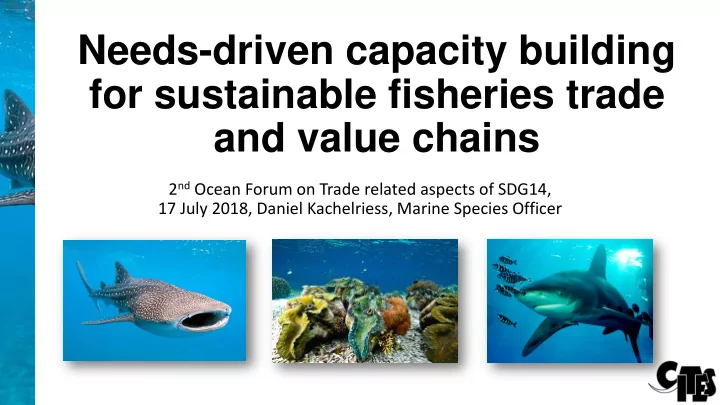

Needs-driven capacity building for sustainable fisheries trade and value chains 2 nd Ocean Forum on Trade related aspects of SDG14, 17 July 2018, Daniel Kachelriess, Marine Species Officer
CITES is a multilateral agreement • Operates through an intergovernmental process • which combines wildlife and trade themes within a legally binding instrument, • achieving conservation and sustainable use objectives • …by setting a common procedural mechanism
Cetorhinus maximus Scleractinia (Stony Corals) (Basking shark) Mobula spp. (Mobula Rays) Anguila anguila (European Eel) Holacanthus clarionensis Carcharhinus longimanus (Clarion Angelfish) (Oceanic whitetip shark) Alopias spp. (Thresher shark) Nautilidae (Nautilus) Rhincodon typus (Whale shark) Hippocampus spp. Strombus gigas (Queen Conch) (Seahorses) Sphyrna lewini , S.mokarran , Cheilinus undulatus S. zygaena (Hammerhead sharks) (Humphead Wrasse) Manta spp. (Manta Rays) Lamna nasus (Porbeagle shark) Carcharodon carcharias (Great Carcharhinus faciformis Pristidae (Sawfish) white shark) (Silky shark)
CITES permits and certificates import export re-export introduction from the sea • Animals and plants (live, dead, parts and derivatives) • Permits and certificates issued under certain conditions: • Lawfully obtained (LAF) • Trade will not be detrimental to the survival of the species (NDF )
Legal Acquisition Finding (LAF) • For a Party to issue a permit authorizing an export: “A Management Authority of the State of export is satisfied that the specimen was not obtained in contravention of the laws of that State for the protection of fauna and flora.” [Convention Article IV 2(b)]
Non-detriment findings (NDFs) “A Scientific Authority of the State of export has advised that such export will not be detrimental to the survival of that species” [Convention Article IV 2(a)] • NDFs are NOT : • One-size-fits-all for all species and countries • A prescriptive ‘standard’ with specific thresholds or demands • Determined by bodies outside of the State of export/introduction from the sea (Examples and guidelines for some species @ CITES website)
Introduction from the Sea (IFS) A A I F S • The same State: • Takes the specimens from the high seas • Acts as the State of introduction, and • Issues an IFS certificate
CITES capacity building activities: Sharks • 2013-2016 Project • Strengthen capacity in developing countries for implementation of CITES provisions for commercially exploited aquatic species • 2-phased approach
Phase 1: Needs assessment • Establish geographic focus • Understand challenges & capacity needs
Phase 2: Addressing identified needs • 2013-2016 project, activities on: • Legality Training material, FAO legal services, measures database • Sustainability JCU, ICCAT, SEAFDEC, IOTC, NPOAs (Carribean) • Traceability Traceability studies, Costa Rica pilot, Identification material database, isharkfin
Partnerships
2017-2019: Ongoing work • (Includes Eels + BCF) • guidance on identified challenges Decisions 17.209 to 17.216 • improvement of training material • needs-tailored capacity building workshops • scale up practical activities • coordination & outreach
The role of CITES • CITES role is at the interface between sustainable use and international trade for fisheries, focusing on species that have declined to a level that requires strong trade and management measures to maintain or rebuilt stocks. • CITES plays a well-targeted role in advancing implementation of SDG 14 as a trade-related measure with effective compliance procedures . • CITES complements the work of other organizations to improve fisheries management
CITES & Blue Biotrade principles: Synergies • CITES vision statement : “Conserve • P1 Conservation of biodiversity biodiversity and contribute to its sustainable use by ensuring that no species of wild fauna • P2 Sustainable use of biodiversity or flora becomes or remains subject to unsustainable exploitation through international trade (…) • P3 Fair and equitable sharing of benefits derived from the use of biodiversity • Resolution Conf. 16.6 (Rev. CoP17): CITES and livelihoods • P4 Socio-economic sustainability (productive, financial and market management) • P5 Compliance with national and international • Legally binding international instrument regulations
Thank you for your attention!
Recommend
More recommend